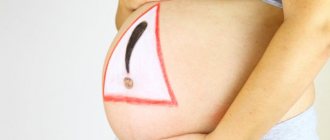There are many methods of traditional and alternative medicine that help avoid unwanted conception. Various methods that help calculate dangerous days for conception are especially popular. These are quite simple but effective techniques that help avoid unnecessary conception or, conversely, calculate the most appropriate time for pregnancy. This is quite convenient, since such techniques allow women to keep their cycle under strict supervision and promptly notice the presence of deviations, irregularities, unusual signs, etc.
When planning, it is important to follow all the specialist’s recommendations
How to prevent unwanted pregnancy
To prevent pregnancy, which is unwanted at this stage of life, women can use various methods of contraception, based on the characteristics of her menstrual cycle and fertilization abilities.
You can prevent pregnancy in this way:
- The calendar method is keeping a schedule of menstruation and calculating dangerous days that are most favorable for conception. A woman uses a simple method to mark the day of ovulation and avoids sexual intercourse for several days before and after.
- Keeping a graph of basal temperature - if you measure the temperature in the rectum every day, early in the morning, you can build a graph that will clearly show the two phases of the menstrual cycle and the moment of ovulation. The chart shows a stable temperature below 37 degrees for the first 10-13 days. Before ovulation, there will be a noticeable sharp fluctuation in temperature, and then its rapid jump above 37 degrees. The day when the temperature was highest before the jump is usually taken as ovulation.
- Study of cervical mucus - in a healthy woman, the color and consistency of vaginal discharge changes during the cycle. This relationship between ovulation and the nature of discharge is determined by the level of hormones. Immediately after menstruation, the body is not ready for conception, so it secretes a thick and sticky secretion that blocks the passage of sperm. About a day before ovulation, the secretion thins out, becomes abundant and transparent. At the end of ovulation, the discharge thickens and disappears after three days. A sterile phase without discharge begins, which lasts until the 1st day of menstruation.
- An ovulation test is the most guaranteed method of determining fertile days. The test strip contains a reagent that reacts to luteinizing hormone, which is released along with urine during the ovulatory period. The test is positive 2 days before and one day after ovulation, indicating dates when additional contraception is required.
Measuring basal temperature allows you to more reliably calculate the ovulation period
Experts believe that the method of measuring basal temperature is more convenient and reliable for calculating “dangerous” and “not dangerous” days for conception.
Basal temperature is the temperature measured in the rectum. You need to measure it correctly in the morning, before getting out of bed. Data is recorded for three to four months, at a minimum. Normally, at the beginning of the menstrual cycle, the temperature does not reach 37.0 degrees (36.6-36.7 ° C). At the time of ovulation, the temperature drops slightly (to 36.2-36.4 ° C), and then steadily remains above 37.0 degrees. The serial number of the day of the cycle on which ovulation occurs, as we have already written, plus minus 3 days (the average lifespan of a sperm) - these are dangerous days for pregnancy.
You can create a kind of calendar to determine dangerous days for pregnancy. In addition to the duration of each cycle, it will also record data after measuring basal temperature. Estimated errors can also be included here. For example, related to stressful situations, alcohol intake, etc.
By the way, such calendars are currently available online. You only need to enter the exact data regarding the beginning of the critical days, and after a few seconds you can obtain the necessary information. According to doctors, the reliability of calculating “dangerous” and “safe” days for conception using basal temperature measurements is 55-60%. But this is only subject to a regular menstrual cycle.
Dangerous days for pregnancy
The method of calculating days favorable for conception is popular among couples who prefer natural birth control. For these purposes, women use the calendar method, study changes in the appearance of cervical mucus during the cycle, do special tests, and even measure basal temperature daily.
Gynecologists are skeptical about such contraception. In their opinion, it is simply impossible to accurately predict the day of ovulation and completely eliminate contact of the finished egg with the sperm. Therefore, it is advised to always resort to additional precautions.
However, in reality, not everything is so complicated and dangerous. Having a clear menstrual cycle, which is correctly displayed in the graph, you can get a fairly high chance of protection.
How to take advantage of the features of the female menstrual cycle?! To avoid unplanned conception, you should understand the process of egg maturation and track the days on which it is capable of fertilization.
The calculation of dangerous days for conception is based on the ovulation process, when the meeting of an egg and a sperm can result in conception. It is important to consider several nuances. Firstly, the egg remains viable for 48 hours after leaving the follicle. Secondly, a full-fledged sperm remains active for 5 days from the moment of penetration into the female body. Such information allows you to find out that only a few days will be dangerous - 4-5 days before ovulation and two days after it.
It is important to note that there is inaccuracy in such calculations for women with irregular periods. However, even in healthy women, ovulation shifts 1-2 times a year, which can cause an unplanned pregnancy. Therefore, to guarantee success, it does not hurt to use additional methods of protection.
Calendar method
This method is convenient and simple. Its essence lies in finding the fertile and infertile stages in the menstrual cycle calendar.
Safe days from pregnancy are determined by the length of the cycle, which usually lasts 28 days (variations are possible - ± 1 week). Ovulation occurs at the end of the second week, that is, 11–14 days after the start of the cycle.
Having determined the day when ovulation occurred, you need to subtract this number from the duration of the entire cycle, and you will get the period characterized by the highest probability of fertilization. It would also be useful to expand its boundaries, adding 3-4 days on each side - the period of time during which sperm remain viable in the female genital tract. The remaining days, accordingly, are considered non-hazardous.
How to calculate dangerous days for pregnancy
To calculate such days, you need to know the exact day of ovulation. For example, if ovulation occurs on the 11th day of the cycle, it is necessary to carry out calculations: 11-6=5, and then to 11+4+15. As a result, days from 5 to 15 days of the cycle will be dangerous.
However, all women ovulate according to an individual plan. Therefore, it is simply impossible to adhere to a single concept for calculating dangerous days. If the cycle is stable, you can track the day of ovulation for three months, for example, using an ultrasound, an ovulation test, or the same basal temperature chart, and then use the table below and protect yourself monthly on dangerous days.
Dangerous days after menstruation
Women are often interested in whether conception can occur immediately after menstruation. In order for ovulation to occur, the hormonal background and endometrium need to recover after menstrual bleeding, so pregnancy does not occur for the first few days after it ends.
Only in rare cases does it happen that the dominant follicle did not ovulate and did not regress before menstruation, and then ruptured at the wrong time. Then conception may still occur after menstruation. But we note that this happens very, very rarely. And, as a rule, it is typical for women with disrupted hormonal levels or gynecological diseases.
Special attention should be paid to the fact that sperm are able to survive in the woman’s genital tract for 3-5 days. Therefore, there is always a chance that the most active sperm can reach its goal and fertilize the egg if a woman ovulates early, for example, not on the eleventh day of the cycle, but on the eighth. Therefore, you need to know the characteristics of your body well in order to determine dangerous days as accurately as possible.
Quick calculation of the day of ovulation using the calendar
Approximately in the middle of the cycle, a mature egg leaves the follicle, at which point it can be fertilized. The viability of the cell is only about a day, after which there is no need to worry about pregnancy. It is also necessary to take into account that sperm in the uterus can live for about two days. Therefore, you need to add a safety period to the expected day of ovulation in order to completely protect yourself.
Let's look at an example of how to calculate the duration of abstinence. Normally, the menstrual cycle is 28 days, and ovulation occurs on the 14th day. If your period began on March 3, then the egg will be ready for fertilization on March 17. We add 4 insurance days on both sides of this date. It turns out that dangerous days for pregnancy are March 13 - 21. You need to forget about unprotected relationships at this time. Not entirely convenient, but free and without side effects. It is convenient to do this with our ovulation calendar.
Dangerous lunar days
Astrologers help many married couples conceive a baby if difficulties arise. They claim that the lunar cycle consists of days that either promote or hinder conception.
In our case, we will pay attention to those days when conception is unlikely. Note that the lunar calendar no longer indicates the inability to conceive, but rather the possible risks associated with pregnancy occurring on days unfavorable for conception. So, dangerous lunar days are 9, 12, 13, 15, 19, 23 and 29 lunar days. These days, the chances of conceiving are minimal, but they still exist, so relying only on such information is undesirable.
Menstrual period - safe days for conception?
The appropriateness of having sex during menstruation also raises many different opinions. Some consider it simply unhygienic. For some, sex during the menstrual period brings additional sensations and pleasure. However, most of the controversy arises over whether you can or cannot get pregnant during your period. And here medicine does not give a specific answer. However, according to research by doctors, it is ectopic pregnancy that is observed in many women who had sex during menstruation.
If the fact of pregnancy is obvious, and the future parents have decided that the birth of a child at the present time will not cause any problems, then it is important to remember that during pregnancy itself there are dangerous days when the gestation of the fetus becomes jeopardized. According to doctors, the entire first trimester is considered the most critical period, when any medications are contraindicated (extremely undesirable).
Especially for beremennost.net Olga Borsuk
Dangerous days calculator
A free online calculator will help simplify the calculation of dangerous and favorable days for conception.
To work with it, you must enter the following data in a special form:
After you click the “Calculate” button, you will receive a calculation where the following information will be schematically depicted in the figure:
- first day of menstruation;
- days of menstruation;
- conditionally safe days for conception;
- ovulation;
- for probable conception;
- safe days for conception.
The results will depend on the characteristics of the menstrual cycle, so each woman will have her own dangerous days for conceiving.
The principles of such contraception
You can track dangerous days for conception using various principles: taking basal measurements, calculating unsafe periods of the monthly cycle, observing changes in cervical mucus and other signs. But, unfortunately, these methods cannot guarantee 100% contraceptive protection, because the results of such calculations are only approximate. During the most dangerous days for conception, the couple will have to give up unprotected sexual intimacy, and if they want to have a baby, then, on the contrary, it is recommended to live an active sex life during these days.
Natural contraception has undoubted advantages, if only because it is possible to calculate safe and dangerous times absolutely free, and there is no negative impact on the female body due to such methods, unlike oral contraception. Although natural contraception also has undoubted disadvantages. For example, it is necessary to keep various records, noting the days of ovulation, and measuring rectal temperature. All this must be done every day.
In addition, such methods only work for those patients who have a stable cycle; only in this case can one count on the effectiveness and accuracy of the methods. Also, an undoubted disadvantage of the natural birth control method is the lack of barrier protection against the possible transmission of sexually transmitted infections. Therefore, married couples can calculate safe/dangerous periods of the cycle using similar methods, so that in the event of an error and unwanted conception, they will keep the child.











